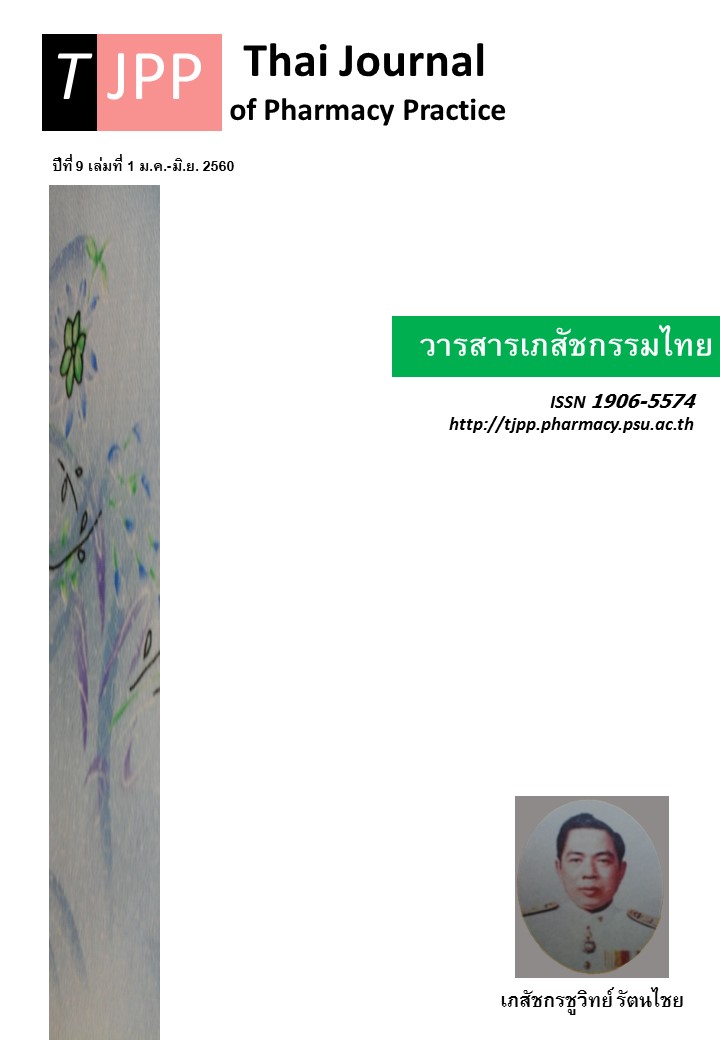ปัจจัยที่สัมพันธ์กับการเกิดกลุ่มอาการเมตาบอลิกในผู้ติดเชื้อเอชไอวี
Main Article Content
บทคัดย่อ
วัตถุประสงค์: เพื่อหาปัจจัยที่สัมพันธ์กับการเกิดกลุ่มอาการเมตาบอลิกในผู้ติดเชื้อเอชไอวี วิธีการ: การศึกษานี้เป็นการวิจัยแบบเก็บข้อมูลย้อนหลังจากผู้ติดเชื้อเอชไอวีที่ได้รับการรักษาด้วยยาต้านไวรัส 266 รายในโรงพยาบาลตำรวจ ตั้งแต่ผู้ติดเชื้อเริ่มการรักษาด้วยยาต้านไวรัสจนถึงปี พ.ศ.2558 การศึกษาวิเคราะห์หาความสัมพันธ์ระหว่างการเกิดกลุ่มอาการเมตา-บอลิกกับปัจจัยต่าง ๆ ได้แก่ เพศ อายุ การดื่มสุรา การสูบบุหรี่ ระดับซีดีโฟร์ในเลือด ระดับไขมันในเลือด ปริมาณไวรัสในเลือด ชนิดของยาต้านไวรัสที่ได้รับ ระยะเวลาในการได้รับยาต้านไวรัส และประวัติการเกิดภาวะไขมันฝ่อลีบ ผลการวิจัย: ผู้ติดเชื้อร้อยละ 62.8 เป็นเพศชาย มีอายุเฉลี่ย 44.7±7.9 ปี ความชุกของการเกิดกลุ่มอาการเมตาบอลิก คือ ร้อยละ 24.8 การวิเคราะห์แบบพหุตัวแปรพบปัจจัยที่เพิ่มความเสี่ยงต่อการเกิดกลุ่มอาการเมตาบอลิก ดังนี้ เพศชายมีความเสี่ยงสูงกว่าเพศหญิง 7.2 เท่า (p<0.001) อายุที่มากกว่าหรือเท่ากับ 45 ปี มีความเสี่ยงเพิ่มขึ้น 2.1 เท่า (p=0.021) ระดับแอลดีแอลในเลือดสูงกว่า 160 มิลลิกรัมต่อเดซิลิตร มีความเสี่ยงเพิ่มขึ้น 6.3 เท่า (p=0.015) และระยะเวลาในการได้รับยาต้านไวรัสนานกว่า 90 เดือน มีความเสี่ยงเพิ่มขึ้น 2.6 เท่า (p=0.003) สรุป: เพศชาย อายุที่มากขึ้น ระดับแอลดีแอลในเลือดสูงกว่า 160 มิลลิกรัมต่อเดซิลิตร และระยะเวลาในการได้รับยาต้านไวรัสที่นานขึ้น เพิ่มความเสี่ยงต่อการเกิดกลุ่มอาการเมตาอลิกในผู้ติดเชื้อเอชไอวีที่ได้รับการรักษาด้วยยาต้านไวรัส ดังนั้นจึงควรมีแนวทางการเฝ้าระวังการเกิดกลุ่มอาการเมตาบอลิกในกลุ่มผู้ติดเชื้อเอชไอวี เพื่อวางแผนป้องกันการเกิดโรคหัวใจและหลอดเลือดต่อไป
Article Details
ผลการวิจัยและความคิดเห็นที่ปรากฏในบทความถือเป็นความคิดเห็นและอยู่ในความรับผิดชอบของผู้นิพนธ์ มิใช่ความเห็นหรือความรับผิดชอบของกองบรรณาธิการ หรือคณะเภสัชศาสตร์ มหาวิทยาลัยสงขลานครินทร์ ทั้งนี้ไม่รวมความผิดพลาดอันเกิดจากการพิมพ์ บทความที่ได้รับการเผยแพร่โดยวารสารเภสัชกรรมไทยถือเป็นสิทธิ์ของวารสารฯ
เอกสารอ้างอิง
2. Mottillo S, Filion KB, Genest J, Joseph L, Pilote L, Poirier P, et al. The metabolic syndrome and cardiovascular risk a systematic review and meta-analysis. J Am Coll Cardiol. 2010;56:1113-32.
3. Galassi A, Reynolds K, He J. Metabolic syndrome and risk of cardiovascular disease: a meta-analysis. Am J Med. 2006;119:812-9.
4. Lohsoonthorn V, Lertmaharit S, Williams MA. Prevalence of metabolic syndrome among professional and office workers in Bangkok, Thailand. J Med Assoc Thai. 2007;90:1908-15.
5. Santibhavank P. Prevalence of metabolic syndrome in Nakhon Sawan population. J Med Assoc Thai. 2007;90:1109-15.
6. Pongchaiyakul C, Nguyen TV, Wanothayaroj E, Karusan N, Klungboonkrong V. Prevalence of metabolic syndrome and its relationship to weight in the Thai population. J Med Assoc Thai. 2007;90:459-67.
7. Jantarapakde J, Phanuphak N, Chaturawit C, Pengnonyang S, Mathajittiphan P, Takamtha P, et al. Prevalence of metabolic syndrome among antiretroviral-naive and antiretroviral-experienced HIV-1 infected Thai adults. AIDS Patient Care STDS. 2014;28:331-40.
8. Friis-Moller N, Thiebaut R, Reiss P, Weber R, Monforte AD, De Wit S, et al. Predicting the risk of cardiovascular disease in HIV-infected patients: the data collection on adverse effects of anti-HIV drugs study. Eur J Cardiovasc Prev Rehabil. 2010;17:491-501.
9. Friis-Moller N, Weber R, Reiss P, Thiebaut R, Kirk O, d'Arminio Monforte A, et al. Cardiovascular disease risk factors in HIV patients--association with antiretroviral therapy. Results from the DAD study. AIDS. 2003;17:1179-93.
10. Feeney ER, Mallon PWG. HIV and HAART-associated dyslipidemia. TOCMJ. 2011;5:49-63.
11. Cunha Jd, Maselii LMF, Stern ACB, Spada C, Bydlowski SP. Impact of antiretroviral therapy on lipid metabolism of human immunodeficiency virus-infected patients: Old and new drugs. World J Virol. 2015;4:56-77.
12. Shahbaz S, Manicadi M, Guaraldi G, Raggi P. Cardiovascular disease in human immunodefi-ciency virus infected patients: A true or perceived risk. World J Cardiol. 2015;7:633-44.
13. Esser S, Gelbrich G, Brockmeyer N, Goehler A, Schadendorf D, Erbel R, et al. Prevalence of cardiovascular diseases in HIV-infected outpatient :results from a prospective, multicenter cohort study. Clin Res Cardiol. 2013;102:203-13.
14. Supawadee Suppadungsuk, Sukit Yamwong, Somnuek Sungkanuparph. Risk of cardiovascular events predicted by the RAMA-EGAT score among HIV-infected pateints in Thailand. Southeast Asian J Trop Med Public Health. 2013;44:818-24.
15. Helleberg M, Kronborg G, Larsen CS, Pedersen G, Pedersen C, Obel N, et al. CD4 decline is associated with increased risk of cardiovascular disease, cancer, and death in virally suppressed patients with HIV. Clin Infect Dis. 2013;57:314-21.
16. Lichtenstein KA, Armon C, Buchacz K, Chmiel JS, Buckner K, Tedaldi EM, et al. Low CD4+ T cell count is a risk factor for cardiovascular disease events in the HIV outpatient study. Clin Infect Dis. 2010;51:435-47.
17. Sacks HS. CD4+ count-guided antiretroviral therapy interruption increased opportunistic disease and death more than continuous therapy in HIV. Evid Based Med. 2009;14:16.
18. Strategies for Management of Antiretroviral Therapy Study, El-Sadr WM, Lundgren J, Neaton JD, Gordin F, Abrams D, et al. CD4+ count-guided interruption of antiretroviral treatment. N Engl J Med. 2006;355:2283-96.
19. Hair JF, Black WC, Babin BJ, Anderson RE. Multivariate data analysis. New Jersy: Pearson Prentice Hall; 2010
20. Samaras K, Wand H, Law M, Emery S, Cooper D, Carr A. Prevalence of metabolic syndrome in HIV-infected patients receiving highly active antiretroviral therapy using International Diabetes Foundation and Adult Treatment Panel III criteria: associations with insulin resistance, disturbed body fat compartmentalization, elevated C-reactive protein, and hypoadiponectinemia. Diabetes Care. 2007;30:113-9.
21. Nguyen KA, Peer N, Mills EJ, Kengne AP. A Meta-analysis of the metabolic syndrome prevalence in the global HIV-infected population. PLoS One. 2016;11.


